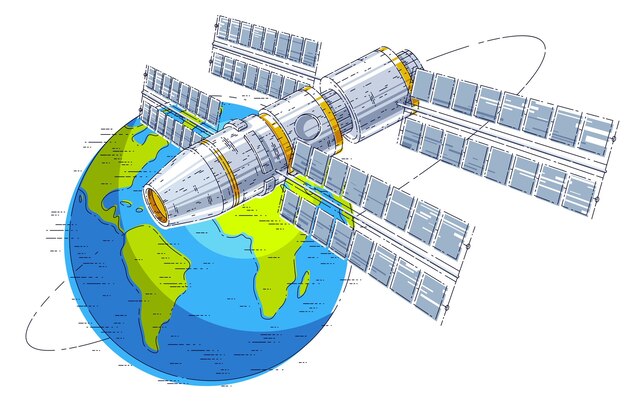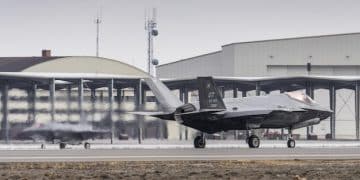New International Space Law Treaty’s Impact on US Space Force

The emergence of a new international space law treaty could significantly reshape US Space Force operations by imposing fresh regulatory frameworks, necessitating adjustments in strategic planning, fostering international cooperation or competition, and influencing budgetary allocations for space-based assets and defense initiatives.
The dawn of a new era in space exploration and utilization brings with it complex challenges, particularly concerning governance and security. A critical question emerging from this evolving landscape is, How Does the New International Space Law Treaty Affect US Space Force Operations? As nations increasingly rely on space for economic and strategic advantages, the legal frameworks governing this domain are becoming paramount.
Understanding the Shifting Sands of Space Law
Space law, a relatively nascent field, has historically been guided by foundational treaties like the Outer Space Treaty of 1967. However, the rapid advancements in space technology, the increasing number of state and private actors, and the potential for weaponization have rendered older frameworks somewhat inadequate. A new international space law treaty aims to address these modern complexities, seeking to establish clearer rules for activity beyond Earth’s atmosphere.
This evolving legal landscape is not simply theoretical; it has tangible implications for entities like the US Space Force. The Space Force, established to protect US interests in space, operates within a dynamic environment where technological superiority must be balanced with legal compliance and international diplomacy. The scope of any new treaty, whether it focuses on resource extraction, debris mitigation, or the prohibition of certain weapons, will directly influence the Space Force’s operational parameters.
Historical Context of Space Governance
For decades, the principles of non-appropriation and peaceful use underpinned space activities. This framework, however, often lacked the specificity required for contemporary challenges. The original treaties were products of a Cold War-era dichotomy, and while visionary for their time, they did not anticipate the commercialization of space or the nuances of dual-use technologies.
- Outer Space Treaty (1967): Established fundamental principles such as the freedom of exploration and use of outer space by all states, non-appropriation of outer space, and the prohibition of nuclear weapons or other weapons of mass destruction in orbit.
- Rescue Agreement (1968): Provided for aid to astronauts and the return of space objects.
- Liability Convention (1972): Established international rules and procedures concerning the liability for damage caused by space objects.
- Registration Convention (1975): Required states to register objects launched into outer space with the UN.
These treaties form the bedrock, yet the current environment demands more granular regulations. The push for a new treaty reflects a global recognition that the current legal vacuum could lead to instability or conflict. Therefore, any new accord is likely to introduce more detailed provisions regarding conduct, responsibility, and enforcement.
The US Space Force, as a military branch tasked with safeguarding national assets and ensuring freedom of action in space, would inevitably find its doctrine, procurement, and training programs reshaped by such a comprehensive legal document. Adapting to these changes will require not only legal scholarship but also strategic foresight and agile implementation.
Strategic Repercussions on US Space Force Doctrine
A new international space law treaty could fundamentally alter the strategic doctrine of the US Space Force. Doctrine, the guiding principles of military action, is shaped by threat assessments, technological capabilities, and legal limitations. Should a new treaty introduce strict prohibitions on certain space-based activities or define new norms of behavior, the Space Force would be compelled to revisit its operational paradigms.
Consider, for instance, a treaty that establishes clearer definitions of “peaceful uses” or “non-aggressive” space activities. Such definitions could constrain the development or deployment of certain types of dual-use technologies or defensive systems. The Space Force, which operates on the philosophy of “deterrence through strength,” might need to redefine what constitutes a deterrent in a legally constrained environment.
Impact on Defensive and Offensive Capabilities
The development and deployment of both defensive and offensive capabilities would be under scrutiny. If a new treaty imposes limitations on counter-space capabilities, such as anti-satellite (ASAT) weapons or kinetic interceptors, the Space Force would need to pivot towards alternative methods of protecting its assets, perhaps focusing more on resilience, maneuverability, and cyber defenses. This shift would have significant implications for research and development budgets.
Furthermore, the treaty might establish definitions for what constitutes an act of aggression in space, necessitating specific responses. This level of clarity, while potentially limiting escalation, also requires the Space Force to have a well-defined escalation ladder and response protocols that align with the new legal framework. The traditional concepts of land, sea, or air warfare do not easily translate to the unique characteristics of the space domain, making legal precision even more critical.
Maintaining a technological edge while adhering to international norms is a delicate balance. The Space Force’s doctrine embodies this challenge, aiming to secure US interests while upholding its commitment to responsible behavior in the global commons. A new treaty, therefore, would not just be a legal document but a strategic imperative that influences everything from tactical operations to long-term national security planning.

Operational Adjustments and Technological Development
The practical implications of a new international space law treaty for US Space Force operations extend directly to day-to-day activities and long-term technological development. Compliance with a new treaty would demand adjustments across the board, from mission planning to the types of satellites launched and the software used to manage them. This ripple effect could reshape the entire ecosystem of US space endeavors.
One of the immediate operational adjustments could involve enhanced transparency and data sharing. If the treaty mandates greater openness regarding satellite launches, orbital pathways, or mission objectives, the Space Force would need to integrate new protocols for sharing information, potentially with international partners or even adversaries, under controlled conditions. This level of transparency could work to de-escalate tensions but also raises concerns about strategic disclosures.
Resource Management and Budgetary Considerations
Any significant shift in operational doctrine or technological development necessitated by a treaty would come with a considerable price tag. Resources, both human and financial, would need to be reallocated. This could mean increased investment in treaty verification technologies, new training programs for personnel, or the complete re-engineering of existing space systems to meet new legal standards.
- R&D Prioritization: Funds might shift from offensive capabilities to defensive resilience or space situational awareness.
- Personnel Training: New legal and diplomatic training for Space Force personnel would become essential.
- Infrastructure Adaptation: Ground stations and command centers may need upgrades to handle new data requirements or compliance checks.
The budgetary implications are not trivial. Congress and the Department of Defense would need to assess how a new treaty aligns with national defense priorities and allocate funds accordingly. This financial element is a critical determinant of how quickly and effectively the Space Force can adapt to a new legal environment.
Moreover, the treaty could influence the types of partnerships the Space Force pursues. Collaboration with commercial space companies, for instance, might be affected if those companies operate under different national legal frameworks or are subjected to new international regulations. Navigating these complex interactions while ensuring compliance would be a continuous challenge for Space Force leadership.
International Cooperation and Competition
A new international space law treaty inevitably carries implications for both international cooperation and competition in space. While treaties often aim to foster cooperation by establishing common rules, they can also inadvertently fuel competition if particular provisions are perceived as disadvantageous or create loopholes for strategic advantage.
For the US Space Force, enhanced cooperation could mean joint exercises with allied nations, shared intelligence on space debris or potential threats, and collaborative efforts to develop responsible norms of behavior. This cooperative approach could strengthen collective security in space and promote stability, aligning with the Space Force’s stated objectives of deterring aggression and ensuring a free and open space domain.
Balancing Collaboration with Strategic Interests
However, the competitive dimension cannot be overlooked. Nations will invariably interpret and implement treaty provisions in ways that align with their national interests. If the treaty is perceived as not adequately addressing certain threats or containing ambiguous clauses, nations might race to develop capabilities that exploit these ambiguities, leading to an arms race in space. The Space Force would need to carefully navigate this duality, balancing cooperation with the imperative to protect US national security interests.
Take, for example, provisions related to space-based resources. If a treaty creates legal frameworks for resource extraction, it could lead to both cooperation in developing mining technologies and intense competition over claimable territories or valuable asteroids. The Space Force, while not directly involved in commercial mining, would be responsible for ensuring the security of US entities engaged in such activities, potentially leading to new operational roles.
Ultimately, a new treaty would serve as a barometer for the global geopolitical climate in space. The US Space Force’s strategy would reflect this, dynamically adjusting its posture between collaborative diplomacy and assertive deterrence. The success of any new treaty hinges on the willingness of major space-faring nations to adhere to its principles, and the Space Force would play a crucial role in monitoring compliance and responding to potential infractions.

Addressing Accountability and Verification
The effectiveness of any new international space law treaty largely hinges on its mechanisms for accountability and verification. Without robust frameworks to ensure compliance and attribute responsibility, even the most well-intentioned treaty risks becoming merely a symbolic gesture. For the US Space Force, these mechanisms are particularly critical as they directly impact its ability to operate effectively and maintain stability in the space domain.
A treaty might introduce new monitoring requirements, potentially involving on-orbit inspections, enhanced data sharing, or independent verification bodies. The Space Force would need to adapt its intelligence, surveillance, and reconnaissance (ISR) capabilities to support these verification efforts, identifying non-compliant activities or potential violations. This would require substantial investment in advanced sensing technologies and analytical tools, further integrating space law into operational planning.
Challenges in Enforcement and Attribution
Enforcement remains perhaps the most significant challenge in international law, and space is no exception. How would violations be penalized? What authority would a treaty body possess to compel compliance? These questions are central to the treaty’s efficacy. From the Space Force’s perspective, unclear enforcement mechanisms could lead to a ‘might makes right’ scenario, undermining stability and potentially necessitating unilateral actions to protect US interests.
- Attribution Difficulties: Identifying the perpetrator of an act in space, such as a cyberattack on a satellite, is notoriously complex. A treaty might provide guidelines for this.
- Dispute Resolution: Establishing clear channels for resolving disputes related to space activities would be crucial to prevent escalation.
- Sanction Mechanisms: The treaty could propose various forms of penalties for non-compliance, from diplomatic censure to more severe economic or strategic consequences.
The Space Force would also need to assess how a new treaty affects its ability to defend against hostile acts. If a treaty prohibits certain defensive measures, the Space Force would be caught between legal compliance and the imperative of self-defense. This tension highlights the importance of carefully crafted treaty language that provides clear parameters for legitimate defensive actions while deterring aggression.
Moreover, the legal and policy teams within the Space Force would need to work closely with international legal experts and diplomats to shape the treaty’s language and ensure that its provisions are both enforceable and pragmatic. The success of the treaty in promoting responsible behavior in space would depend heavily on these ongoing dialogues and the willingness of nations to accept robust accountability measures.
Future Outlook and Adaptability of the US Space Force
The landscape of space is constantly evolving, driven by technological breakthroughs, economic pressures, and geopolitical shifts. A new international space law treaty, while aiming to bring order, will also necessitate continuous adaptability from the US Space Force. The future outlook for Space Force operations will be one of dynamic adjustment, requiring foresight and flexible strategic planning.
The treaty might act as a catalyst for innovation, encouraging the development of technologies that are compliant with new regulations, such as more resilient satellite systems, advanced debris removal methods, or non-kinetic forms of deterrence. In this sense, legal constraints could paradoxically drive technological progress in unforeseen directions, fostering a more sustainable and secure space environment.
Long-Term Strategic Planning
Long-term strategic planning for the Space Force would need to integrate potential future revisions of such a treaty. Space law is unlikely to remain static; as technology advances and humanity’s presence in space expands, the legal frameworks will need periodic updates. This implies an enduring role for legal and diplomatic engagement within the Space Force, ensuring that military operations remain aligned with evolving international consensus.
The Space Force would also need to consider the impact on its workforce. Recruiting and training personnel with expertise not only in military operations and space technology but also in international law and diplomacy would become increasingly vital. This interdisciplinary approach would ensure that the Space Force remains agile and capable of navigating the complex legal and operational challenges of the 21st century’s space domain.
Ultimately, how does the new international space law treaty affect US Space Force operations? It compels a comprehensive re-evaluation of doctrine, technology, and partnerships. It demands a sophisticated balance between protecting national interests and contributing to global stability in humanity’s new frontier. The Space Force’s adaptability and willingness to engage proactively with these legal shifts will be paramount to its continued effectiveness and legitimacy on the global stage.
| Key Aspect | Brief Description |
|---|---|
| ⚖️ Doctrinal Shift | New legal definitions may alter what constitutes aggression or deterrence, necessitating updated operational guidelines. |
| 💡 Tech Development | Emphasis might shift to compliant technologies like resilience and debris mitigation, influencing R&D investments. |
| 🤝 Global Dynamics | Treaty could foster cooperation for stability or intensify competition over strategic advantages and resources. |
| ✅ Accountability | New verification and enforcement mechanisms would require adapting ISR capabilities and legal expertise. |
Frequently Asked Questions About Space Law and US Space Force
A new treaty is expected to address emerging challenges like space resource utilization, debris mitigation, clearer definitions of peaceful space activities, and the regulation of dual-use technologies. It aims to fill gaps in existing legal frameworks and prevent conflicts in an increasingly congested and contested space domain.
The treaty could influence the types of capabilities the Space Force can develop and deploy, potentially shifting focus towards technologies compliant with new regulations. It may also necessitate a re-evaluation of deterrence strategies, emphasizing resilience and cyber defenses over certain kinetic options, while enhancing cooperation with allies.
Depending on its specific provisions, a treaty might impose limitations on certain counter-space technologies or define what constitutes an act of aggression in space. The US Space Force would need to adapt by developing new defensive strategies and ensuring its actions align with the treaty while maintaining its ability to protect US assets.
A new treaty is likely to emphasize coordinated efforts in space governance, debris management, and possibly joint ventures for exploration or resource extraction. The US Space Force would likely engage more deeply with international partners, sharing information and best practices to foster stability and mutual security in space.
Maintaining a strategic edge will involve prioritizing innovation in compliant technologies, enhancing space situational awareness, and refining deterrence strategies to align with legal norms. The Space Force will also rely heavily on diplomatic engagement and collaboration with allies to shape and uphold a stable and secure space environment.
Conclusion
The advent of a new international space law treaty marks a pivotal moment for space governance and, by extension, for entities like the US Space Force. As nations navigate the intricate balance between exploration, exploitation, and security in Earth’s orbital frontier, the legal frameworks that emerge will dictate the parameters of engagement. For the US Space Force, this translates into a multifaceted imperative: adapting its doctrine, investing in compliant technologies, fostering strategic international partnerships, and rigorously adhering to enhanced accountability measures. The ability of the Space Force to remain agile, innovative, and deeply informed by these evolving legal landscapes will be crucial in safeguarding US interests and promoting long-term stability in humanity’s shared cosmic domain.





